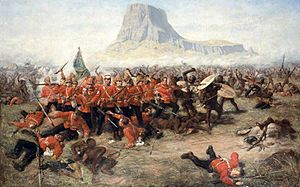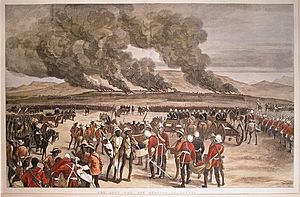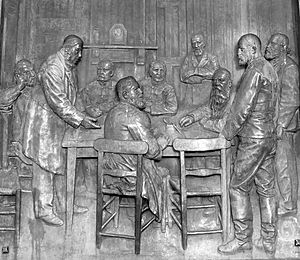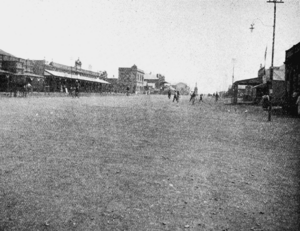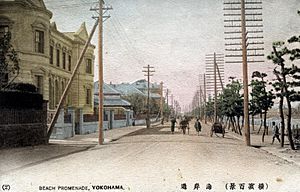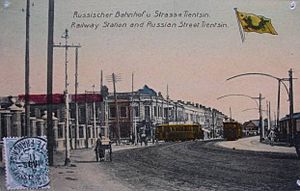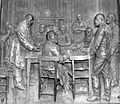Charles Norris-Newman facts for kids
Quick facts for kids
Charles Norris-Newman
|
|
|---|---|
| Born | 22 August 1852 Elvington Hall, Yorkshire, England
|
| Died | May 1920 (aged 67) Victoria Hospital, Tientsin, China
|
| Occupation |
|
| Spouse(s) |
|
| Children | 1 |
Charles Norris-Newman (born August 22, 1852 – died May 1920) was a British journalist and adventurer. He also worked as an intelligence officer for the Russian Navy. He saw many important historical events. For example, he was in Paris during the Siege of Paris in 1870–1871. He also reported from Spain during the Third Carlist War (starting in 1872). Later, he joined General Charles George Gordon in Egypt.
Norris-Newman arrived in Southern Africa in 1877. He was the only newspaper reporter with the British forces during the Zululand invasion in 1879. He reported for The Standard newspaper. He was at the Action at Sihayo's Kraal. He also narrowly missed the terrible Battle of Isandlwana. He was among the first people to ride into Rorke's Drift after that famous battle. Norris-Newman even fought in the Battle of Gingindlovu. He was the first to enter the besieged town of Eshowe. He also saw the final battle, the Battle of Ulundi.
After the war, he stayed in the area. He covered the short First Boer War of 1880–1881. Later, he joined Digby Willoughby in Basutoland and Madagascar. By the mid-1890s, he worked with the British South Africa Company. He helped them take over Matabeleland. He published two newspapers and worked for Reuters. He also managed a messenger company. He served as an intelligence officer during the Second Matabele War of 1896–1897. From 1902, Norris-Newman worked for the Imperial Russian Navy. He taught English and published a journal in the Far East. He was accused of spreading false information during the 1904–1905 Russo-Japanese War. In his later years, he worked for newspapers in China.
Contents
Early Life and Adventures
Charles Norris-Newman was born on August 22, 1852. His birthplace was Elvington Hall in Yorkshire, England. His parents were C. Sherwood Newman and the Countess de Rosa Y Robyns. He went to schools like Sherborne, Lubeck, and Harrow. He also received military training.
Historian Ian Knight noted that some people thought Norris-Newman was a British Army officer. However, there is no clear proof of this. Norris-Newman was in Paris during the Franco-Prussian War. He saw the Siege of Paris (1870–1871). The city's governor, Louis-Jules Trochu, even honored him for his service there. He traveled with Infante Carlos, Duke of Madrid during the Third Carlist War (1872–1876). From 1873, he was with General Charles George Gordon in Egypt. In 1874, he married Anne Falkner.
Reporting the Anglo-Zulu War
Norris-Newman arrived in Southern Africa in 1877. When the Anglo-Zulu War began in early 1879, he was the only reporter with the British army. Other British reporters were busy with the Second Anglo-Afghan War. Norris-Newman worked as a special reporter for The Standard. His reports also appeared in local newspapers like the Times of Natal and the Cape Standard and Mail.
Norris-Newman joined Lord Chelmsford's main force. He rode with the 3rd Regiment of the Natal Native Contingent (NNC). This was a unit of black African soldiers led by white officers. The unit's leader, Rupert la Trobe Lonsdale, gave him the nickname "Noggs." This name came from a character in a Charles Dickens novel.
On January 11, Norris-Newman was the first person to cross the Buffalo River into Zululand. He swam his horse across at 5:00 am, before the army started crossing. He went with Chelmsford to watch the first battle of the war. This was the Action at Sihayo's Kraal on January 12.
Norris-Newman was lucky to avoid the Battle of Isandlwana on January 22. In this battle, the British camp was destroyed. He was with the 3rd NNC and Chelmsford on a scouting trip that morning. Norris-Newman returned to the battlefield later that day. They camped among the dead before heading to Rorke's Drift. He was with the first group to enter Rorke's Drift. They found that the defenders had won the battle.
Norris-Newman quickly gathered news about the defense. Then he rode to the telegraph office in Pietermaritzburg. From there, he sent his report to The Standard. The news reached Cape Town by telegraph. Then it had to be carried by ship to Cape Verde, where a telegraph line connected to London. His story was the first news of the defeat. It appeared in British newspapers twenty days after the battle. This report made Norris-Newman famous in journalism. The report also included a list of casualties. It was printed locally in an extra edition of the Natal Times on January 24.
After the defeat, other top British reporters came to Natal. These included Melton Prior, Charles Edwin Fripp, and Archibald Forbes. The Standard sent F.R. MacKenzie to help Norris-Newman. Norris-Newman and Forbes returned to Isandlwana on March 20. They were with a British group sent to bury some of the dead.
Norris-Newman also joined the group sent to help the Siege of Eshowe. During this trip, he was at the Battle of Gingindlovu on April 2. At one point, the fighting was so intense that he grabbed a rifle and helped. He shot at least one Zulu warrior. After the battle, he and a friend found three dead Zulu warriors. They took items from them as trophies. Norris-Newman was the first person to enter Eshowe when it was rescued. He raced another reporter and won by five minutes. Norris-Newman was also present at the final British victory of the war, the Battle of Ulundi, on July 4.
Norris-Newman wrote a book about the Anglo-Zulu War. It was called On Campaign with the British Army in the Zulu War of 1879. It was published in 1880. A historian named Donald R. Morris said the book was "brisk and accurate" for the parts Norris-Newman saw. Norris-Newman was also shown in the 1979 film Zulu Dawn. He was played by actor Ronald Lacey.
Later Adventures in Africa
Norris-Newman was still in Southern Africa when the First Boer War started in late 1880. This war was between the British and the Transvaal Boers. He wanted to report on the war from the Boer side. However, he could not reach their lines before the fighting stopped. Norris-Newman stayed to watch the peace talks. He wrote a book called With the Boers in the Transvaal about his experiences.
By 1882, he was in Basutoland, after the Basuto Gun War. Later, he joined the adventurer Digby Willoughby in Madagascar. Willoughby had also served in the Zulu War. He became a general in the army of Madagascan queen Ranavalona III. This army fought the French in the First Franco-Hova War (1883-1885).
By 1885, Norris-Newman was back in Southern Africa. He worked as a town clerk and treasurer in Aliwal North in Cape Colony. He was dismissed after 18 months. Norris-Newman then reported on military campaigns in Zanzibar and Central Africa until 1891. His reports appeared in newspapers like The Times and the Daily Mail. He also wrote books called The Basuto and their Country and South African Stories.
In the mid-1890s, Norris-Newman worked with the British South Africa Company (BSAC). This company was taking over Matabeleland. By 1894, Norris-Newman was publishing the Matabeleland News and Mining Record. He also worked as an agent for the Reuters news service. He set up a postal service using runners from Bulawayo to the telegraph line. In 1895, he published Matabeleland And How We Got it. This book explained how the BSAC gained the territory.
By 1896, Norris-Newman was the editor and owner of the Rhodesia Weekly Review. He visited England for a lecture tour. During the Second Matabele War of 1896–1897, he served as a staff officer. He was also the chief intelligence officer for the Bulawayo Field Force.
Life in East Asia
Norris-Newman left Africa for East Asia before 1900. He spent time in Ceylon, Malaya, China, and Japan. On January 14, 1900, he married Ethel Luke Finch in Japan.
In 1902, Norris-Newman started working for the Imperial Russian Navy. He taught English at Port Arthur.
Norris-Newman reported as a freelance correspondent during the 1904-1905 Russo-Japanese War. He reported from the Russian side. He saw the Siege of Port Arthur. He started the China Review in Hankow. This was the first Russian journal in the Far East. During this time, Russia gave him the rank of lieutenant-colonel. He was paid a good salary.
Later Life and Interests
Not much is known about Norris-Newman's later life. He tried to avoid attention. By 1907, he was working as an intelligence officer for Russia. By 1910, he lived in Tientsin and worked for the China Critic. By 1916, he worked for the Gazette in Peking.
His entry in Who's who in the Far East, 1906–7 lists several awards. These include "Madagascar, first class," the Order of the Dannebrog, the "French Medal for Valour," the Egypt Medal, the Khedive's Star, the South Africa Medal (1880), and the British South Africa Company Medal. His hobbies were riding, shooting, and stamp collecting. He was also a member of the Royal Geographical Society.
Norris-Newman's interest in stamp collecting started early. He was elected a member of the Birmingham Philatelic Society in 1896. He died of stomach cancer in May 1920 at Victoria Hospital in Tientsin.
Images for kids




